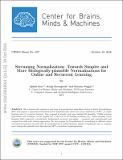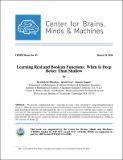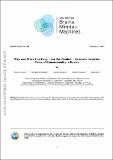Search
Now showing items 1-5 of 5
Streaming Normalization: Towards Simpler and More Biologically-plausible Normalizations for Online and Recurrent Learning
(Center for Brains, Minds and Machines (CBMM), arXiv, 2016-10-19)
We systematically explored a spectrum of normalization algorithms related to Batch Normalization (BN) and propose a generalized formulation that simultaneously solves two major limitations of BN: (1) online learning and ...
View-tolerant face recognition and Hebbian learning imply mirror-symmetric neural tuning to head orientation
(Center for Brains, Minds and Machines (CBMM), arXiv, 2016-06-03)
The primate brain contains a hierarchy of visual areas, dubbed the ventral stream, which rapidly computes object representations that are both specific for object identity and relatively robust against identity-preserving ...
Bridging the Gaps Between Residual Learning, Recurrent Neural Networks and Visual Cortex
(Center for Brains, Minds and Machines (CBMM), arXiv, 2016-04-12)
We discuss relations between Residual Networks (ResNet), Recurrent Neural Networks (RNNs) and the primate visual cortex. We begin with the observation that a shallow RNN is exactly equivalent to a very deep ResNet with ...
Learning Real and Boolean Functions: When Is Deep Better Than Shallow
(Center for Brains, Minds and Machines (CBMM), arXiv, 2016-03-08)
We describe computational tasks - especially in vision - that correspond to compositional/hierarchical functions. While the universal approximation property holds both for hierarchical and shallow networks, we prove that ...
Theory I: Why and When Can Deep Networks Avoid the Curse of Dimensionality?
(Center for Brains, Minds and Machines (CBMM), arXiv, 2016-11-23)
[formerly titled "Why and When Can Deep – but Not Shallow – Networks Avoid the Curse of Dimensionality: a Review"]
The paper reviews and extends an emerging body of theoretical results on deep learning including the ...





